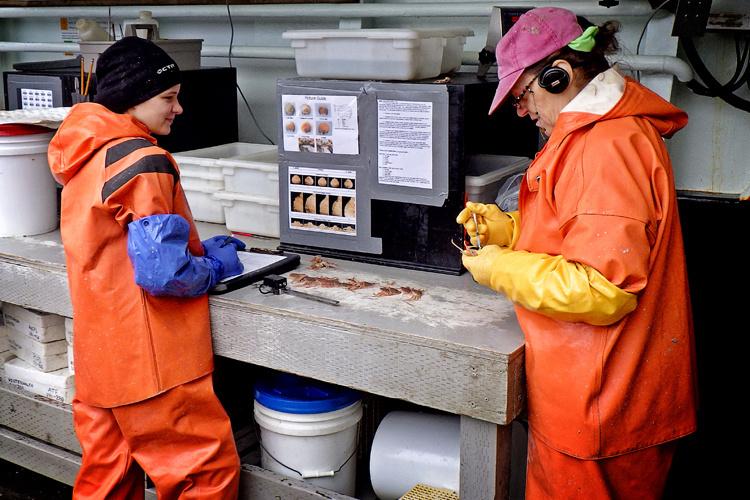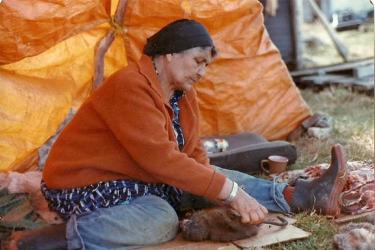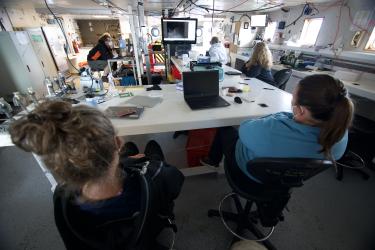Our Floating Laboratory
When conducting research surveys in Alaska, we often charter commercial fishing vessels. This allows us to maximize limited boat time aboard NOAA ships while working collaboratively with the commercial fishing industry. On charter vessels, we have the benefit of the fishing and problem-solving skills of the professional fishermen on board. However, lacking the facilities of a research vessel, every year we pack needed scientific equipment, ship it to Dutch Harbor, and load it onto these vessels to use.

The map shows the sampling grid for the 2017 eastern and northern Bering Sea shelf bottom trawl survey (June 1 and August 30th, 2017). The map will be updated several times each week to show the progress of the survey vessels and the bottom temperature (°C) in each 20x20 nautical grid cell.
Our primary goal is to sample fish and crabs to support our stock assessments, which fishery managers then use to develop management measures for commercial fisheries in Alaska. We also may conduct 20-30 research projects for scientists who are unable to come to the Bering Sea themselves. We take tissue samples of fish for DNA research. We extract crab blood samples for investigating the pathology of diseases. We collect and preserve animals for examination back on land. We also conduct experiments to assess the effectiveness of our own survey methods. The goal is to ensure the highest quality information possible.
All of our work is done on the deck of the boat, so we have to keep our equipment organized and accessible. When we are not using equipment or in the event of poor weather, it must be stowed properly. Since our surveys are conducted in legs, we typically change survey teams at the start of each new leg. New teams need to be briefed on the ongoing research studies and where the equipment is stored.
Despite the challenges of transforming fishing vessels into research platforms, I believe doing this work on chartered boats is invaluable.
Thanks to the fishing crews, we are able to get a hefty amount of sampling done each summer. And the dialogue that opens up between researchers and fishermen as we live and work together enriches both parties. I’ve learned so much from the fishermen that I’ve worked with over the years, and I appreciate the opportunity to share the knowledge I have gained as a scientist with them too!

Crystal Peterson (IPHC), Dan Nichol (AFSC) and Jason Conner (AFSC) take genetic samples from pollock.
Meet the Bloggers

Bob Lauth
Bob Lauth has been a Fisheries Research Biologist for the NOAA Alaska Fisheries Science Center in Seattle for 26 years. Bob leads the Bering Sea Group, which is responsible for conducting summertime surveys of bottom fish, crabs, and other bottom-dwelling creatures in the offshore marine waters of Alaska. Fascinated by Jacques Cousteau as a kid, Bob moved from Chicago to the 'ever-green' Seattle in 1980 to become a marine biologist without the slightest idea how to earn a living. After working three years in a dive store, teaching scuba diving, and doing marine field trips with school kids in the Puget Sound, Bob learned about the 'fishy side’ to marine biology. He enrolled at the University of Washington School of Fisheries, earned a Master’s degree, and then worked for the Inter-American Tropical Tuna Commission at a remote marine lab in Central America before returning to the northwest with his wife to raise a family and pursue his career in fisheries.

Jason Conner
Jason Conner is a fishery biologist who researches the groundfish populations of the Bering Sea. He began his career with NOAA Fisheries in Woods Hole, MA, at the Northeast Fisheries Science Center, helping to record data on whale and seal populations in the Atlantic. He also spent two years in Gloucester, MA, working on fisheries data reporting systems for the Northeast Regional Office. Jason grew up in Denver, CO, but he has had a passion for the ocean since he was two years old. In his free time, Jason enjoys acting in community theater, playing ice hockey, and diving (with and without SCUBA).


